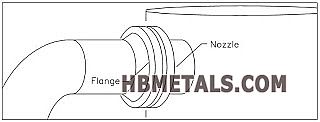PRODUCT CATEGORY
CONTACT US
- Tel: 0086-311-89642206
- Fax: 0086-311-67906676
- Mobile: 0086-15076331069 13933856228
- E-mail: sales@hbmetals.com
- E-mail: info@hbmetals.com
Basic Knowledge of Flange 01
Generally speaking, the flange is a ring-shaped device designed to be used as an alternative to welding or threading various piping system components used throughout the piping system. Flanged connections are used as an alternative to welding because they can be easily disassembled for shipping, routine inspection, maintenance, or replacement. Flange ends are preferred over threaded connections because threading large bore pipe is not an economical or reliable operations. The flange is an important component of any piping system.
Flanges are primarily used where a connecting or dismantling joint is needed. There joints may include joining pipe to fittings, valves, equipment, or any other integral component within the piping system.
To erect the piping system, every piece of mechanical equipment is manufactured with at least one outlet called a nozzle. The nozzle is the point where, via the flange, the piping system is connected to the equipment. From this flange, the piping system is begun.

A) The ratings of flanges
Rating, as applied to flanges, may best be defined as maximum pressure allowed by the pressure piping code for the specific temperature at which the flange will be operating.Flanges and nozzles are sized according to pressure ratings established by the American National Standard Institute(ANSI). These pressure ratings, sometimes called pound ratings, are divided into seven categories for forged steel flanges. They are 150#, 300#, 400#, 600#, 900#, 1500#, and 2500#. Cast iron flanges have pound ratings of 25#, 125#, 250#, and 800#.
Pound Ratings, when combined with the temperature of the medium within the pipe, are used to select the appropriate size, rating, and type of flange. This pressure/temperature relationship will allow any given flange to be used in a number of different applications. For example, a 150# forged steel flange is rated to perform at 150# PSIG at 500F. If the temperature were decreased to 100F, this same flange could be used for 275# PSIG. However, if the temperature were increased to 750F, the flange could only be used for 100# PSIG. As you can see, the pressure/temperature relationship is very important. When temperature decreases the allowable pressure increases and vice versa. Pound ratings are also used the outside diameter and thickness of the flange. Typically, as pound ratings increase, so the flange's diameter and thickness.
B) Flange Facings
The mating surface of a flange, nozzle, or valve is called the faces. The face is usually machined to create a smooth surface. This smooth surface will help assure a leak-proof seal when two flanges are bolted together with a gasket sandwiched between.
Although numerous types of flange faces are produced, normally the following three are most often used,
a) Flat Face
b) Raised Face
c) Ring Type Joint
a) Flat Face(abbreviated for FF) As the name implies, flanges with flat faces are those that have a flat, level connecting surface. Forged steel flanges with a flat face flange are commonly found in 150# and 300# ratings. Their principal use is to make connection withs with 125# and 250# cast iron flanges, respectively. Attaching steel pipe to the cast iron flanges found on some valves and mechanical equipment always presents a problem because of the brittle nature of cast iron. Using a flat face flange will assure full surface contact, thereby reducing the possibility of cracking the softer cast iron.
b) Raised Face(abbreviated for RF) The most common type in use, the raised face is available in all seven of the aforementioned pound ratings. Appropriately named, this flange face has a prominent raised surface. With shallow grooves etched into raised surface, this flange face assures a positive grip with the gasket. Flanges rated 150# and 300# have a 1/16"(1.6mm) raised face, while flanges rated 400# and above have a 1/4"(6.4mm) raised face. It is important to note most dimensioning charts, include the 1/16" raised face thickness in the length dimensions for 150# and 300# flanges. However the 1/4" raised face is thickness is not always included in the length dimensions for 400# and higher pound ratings.
c) Ring Type Joint Face(abbreviated for RTJ) Also known as ring joint, the ring type joint does not use a gasket to form a seal between connecting flanges. Instead a round metallic ring is used that rests in a deep groove cut into the flange face. The donut-shaped ring can be oval or octagonal in design. As the bolts are tightened, the metal ring is compressed, creating a tight seal.
Although it is more expensive, the ring type joint is considered to be the most efficient flange used in process piping systems. The ring and groove design actually uses internal pressures to enhance the sealing capacity of the connecting flange. The superiority of this seal can have its disadvantages, however. When dismantling ring type joint connections, the flanges must be forcibly separated to release the ring from the groove. In crowded installations, this could cause major problems. Because of this, the ring joint flange is relegated to applications where space for maintenance and replacement are adequate. Although available for all pound ratings, flanges with ring joint faces are normally used in piping systems rated 400# and higher.
Views: Author:METALS INDUSTRIAL Date:07/07/22









